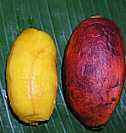Karat banana

Karat banana (Musa troglodytarum) is a unique cultivar of banana native to the Federated States of Micronesia, particularly the island of Pohnpei. It is known for its distinctive orange-red flesh, which is rich in beta-carotene, a precursor of vitamin A. The Karat banana is an important part of the local diet and has been traditionally used for its nutritional benefits.
Description[edit]
The Karat banana plant is similar in appearance to other banana plants, with large, broad leaves and a pseudostem that can reach up to 3 meters in height. The fruit itself is shorter and stubbier compared to the common Cavendish banana, with a thick peel that turns from green to yellow-orange as it ripens. The flesh inside is a vibrant orange-red color, which is indicative of its high beta-carotene content.
Nutritional Value[edit]
Karat bananas are particularly noted for their high levels of beta-carotene, which is converted into vitamin A in the human body. This makes them an excellent food source for preventing vitamin A deficiency, which can lead to serious health issues such as blindness and increased susceptibility to infections. In addition to beta-carotene, Karat bananas also provide other essential nutrients such as potassium, vitamin C, and dietary fiber.
Cultural Significance[edit]
In Pohnpei, the Karat banana holds significant cultural value. It is often used in traditional ceremonies and is considered a symbol of health and prosperity. The banana is also a staple food for infants and young children due to its soft texture and high nutritional content.
Cultivation[edit]
Karat bananas are typically grown in small-scale, traditional agricultural systems. The plants thrive in the tropical climate of Micronesia, with abundant rainfall and warm temperatures. They are usually propagated through suckers, which are young shoots that grow from the base of the parent plant.
Health Benefits[edit]
The high beta-carotene content in Karat bananas makes them particularly beneficial for eye health. Consuming these bananas can help prevent night blindness and other eye-related issues. Additionally, the fruit's high fiber content aids in digestion and helps maintain a healthy gut.
Related Pages[edit]
Categories[edit]
Ad. Transform your life with W8MD's Budget GLP-1 injections from $75


W8MD offers a medical weight loss program to lose weight in Philadelphia. Our physician-supervised medical weight loss provides:
- Weight loss injections in NYC (generic and brand names):
- Zepbound / Mounjaro, Wegovy / Ozempic, Saxenda
- Most insurances accepted or discounted self-pay rates. We will obtain insurance prior authorizations if needed.
- Generic GLP1 weight loss injections from $75 for the starting dose.
- Also offer prescription weight loss medications including Phentermine, Qsymia, Diethylpropion, Contrave etc.
NYC weight loss doctor appointmentsNYC weight loss doctor appointments
Start your NYC weight loss journey today at our NYC medical weight loss and Philadelphia medical weight loss clinics.
- Call 718-946-5500 to lose weight in NYC or for medical weight loss in Philadelphia 215-676-2334.
- Tags:NYC medical weight loss, Philadelphia lose weight Zepbound NYC, Budget GLP1 weight loss injections, Wegovy Philadelphia, Wegovy NYC, Philadelphia medical weight loss, Brookly weight loss and Wegovy NYC
|
WikiMD's Wellness Encyclopedia |
| Let Food Be Thy Medicine Medicine Thy Food - Hippocrates |
Medical Disclaimer: WikiMD is not a substitute for professional medical advice. The information on WikiMD is provided as an information resource only, may be incorrect, outdated or misleading, and is not to be used or relied on for any diagnostic or treatment purposes. Please consult your health care provider before making any healthcare decisions or for guidance about a specific medical condition. WikiMD expressly disclaims responsibility, and shall have no liability, for any damages, loss, injury, or liability whatsoever suffered as a result of your reliance on the information contained in this site. By visiting this site you agree to the foregoing terms and conditions, which may from time to time be changed or supplemented by WikiMD. If you do not agree to the foregoing terms and conditions, you should not enter or use this site. See full disclaimer.
Credits:Most images are courtesy of Wikimedia commons, and templates, categories Wikipedia, licensed under CC BY SA or similar.
Translate this page: - East Asian
中文,
日本,
한국어,
South Asian
हिन्दी,
தமிழ்,
తెలుగు,
Urdu,
ಕನ್ನಡ,
Southeast Asian
Indonesian,
Vietnamese,
Thai,
မြန်မာဘာသာ,
বাংলা
European
español,
Deutsch,
français,
Greek,
português do Brasil,
polski,
română,
русский,
Nederlands,
norsk,
svenska,
suomi,
Italian
Middle Eastern & African
عربى,
Turkish,
Persian,
Hebrew,
Afrikaans,
isiZulu,
Kiswahili,
Other
Bulgarian,
Hungarian,
Czech,
Swedish,
മലയാളം,
मराठी,
ਪੰਜਾਬੀ,
ગુજરાતી,
Portuguese,
Ukrainian
